Rose of Lima
Rose of Lima, TOSD (born Isabel Flores de Oliva; 20 April 1586 – 24 August 1617) was a member of the Third Order of Saint Dominic in Lima, Peru, who became known for both her life of severe penance[4] and her care of the poverty stricken of the city through her own private efforts. Rose of Lima was born to a noble family and is the patron saint of embroidery, gardening and cultivation of blooming flowers. A lay member of the Dominican Order, she was declared a saint by the Catholic Church, being the first person born in the Americas to be canonized as such.[1]
Rose of Lima | |
|---|---|
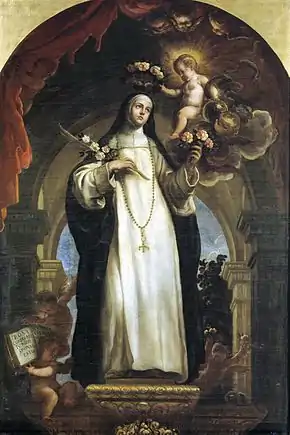 | |
| Virgin | |
| Born | Isabel Flores de Oliva April 20, 1586[1] Lima, Viceroyalty of Peru |
| Died | August 24, 1617 (aged 31)[1] Lima, Viceroyalty of Peru |
| Venerated in | Catholic Church |
| Beatified | April 15, 1667 or 1668, Rome, Papal States by Pope Clement IX |
| Canonized | April 12, 1671, Rome, Papal States by Pope Clement X[1] |
| Major shrine | Basilica of Santo Domingo Lima, Peru |
| Feast | August 23 August 30 (some Latin American countries and pre-1970 General Roman Calendar) |
| Attributes | Dominican tertiaries' habit, roses, anchor, Infant Jesus |
| Patronage | embroiderers; sewing lace; gardeners; florists; people ridiculed or misunderstood for their piety; for the resolution of family quarrels; against vanity; indigenous peoples of the Americas; Latin America; Peru; Philippines; the Indies;[2] Villareal; Santa Rosa, California; Santa Rosa, Laguna; Santa Rosa, Nueva Ecija; Alcoy, Cebu; Daanbantayan, Cebu; Arima, Trinidad and Tobago;[3] Lima; Sittard |
As a saint, Rose of Lima has been designated as a co-patroness of the Philippines along with Pudentiana; both saints were moved to second-class patronage in September 1942 by Pope Pius XII, but Rose remains the primary patroness of Peru and of the local people of Latin America. Her image is featured on the highest denomination banknote of Peru.
Biography
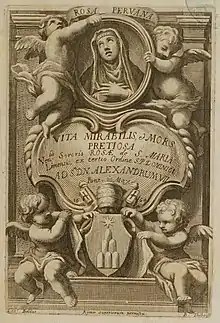
She was born as Isabel Flores de Oliva in the city of Lima, then in the Viceroyalty of Peru, on 20 April 1586. She was one of eleven children of Gaspar Flores, a harquebusier in the Imperial Spanish army whose family were from Baños de Montemayor, Cáceres, Spain and later travelled to Puerto Rico.[5][6] His wife and Rose's mother, María de Oliva y Herrera (b. 1560), was a criolla native of Lima.[7] Her maternal grandparents were Francisco de Oliva and Isabel de Herrera. Rose’s siblings (in birth order) were Gaspar, Bernardina, Hernando, Francisco, Juana, Antonio, Andrés, Francisco and Jacinta, all born in Lima.[8]

Her later nickname "Rose" comes from an incident in her infancy: a servant claimed to have seen her face transform into a rose. In 1597 Isabel was confirmed by the Archbishop of Lima, Toribio de Mogrovejo, who was also to be declared a saint. She formally took the name of Rose (Rosa in Spanish) at that time.[4]
As a young girl, in emulation of the noted Dominican tertiary Catherine of Siena, she began to fast three times a week and performed severe penances in secret. When she was admired for her beauty, Rose cut off her hair and rubbed peppers on her face, upset that men were beginning to take notice of her.[9] She rejected all suitors against the objections of her friends and her family. Despite the censure of her parents, she spent many hours contemplating the Blessed Sacrament, which she received daily, an extremely rare practice in that period. She was determined to take a vow of virginity, which was opposed by her parents who wished her to marry.[4] Finally, out of frustration, her father gave her a room to herself in the family home.
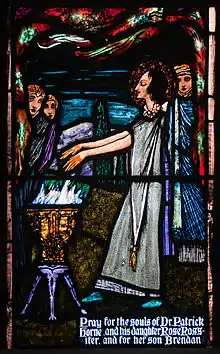
After daily fasting, she took to permanently abstaining from eating meat. She helped the sick and hungry around her community, bringing them to her room and taking care of them. Rose sold her fine needlework and took flowers that she grew to market, to help her family. She made and sold lace and embroidery to care for the poor, and she prayed and did penance in a little grotto that she had built. Otherwise, she became a recluse, leaving her room only for her visits to church.[9]
She attracted the attention of the friars of the Dominican Order. She wanted to become a nun, but her father forbade it, so she instead entered the Third Order of St. Dominic while living in her parents' home. In her twentieth year, she donned the habit of a tertiary and took a vow of perpetual virginity. She only allowed herself to sleep two hours a night at most so that she had more hours to devote to prayer.[10] She donned a heavy crown made of silver, with small spikes on the inside, in emulation of the Crown of Thorns worn by Christ.[9]
For eleven years she lived this way, with intervals of ecstasy, and eventually died on 24 August 1617, at the young age of 31, after a long illness. It is said that she prophesied the date of her death. Her funeral was held in the cathedral, attended by all the public authorities of Lima. Her feast day is on the 23rd day of August (the 30th day of August in the Traditional calendar).
Veneration
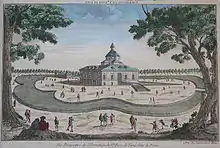
Rose was beatified by Pope Clement IX on 10 May 1667, and canonized on 12 April 1671, by Pope Clement X, and was the first Catholic in the Americas to be declared a saint.[1] Her shrine, alongside those of her friends Martin de Porres and John Macias, is currently located inside of the convent of Saint Dominic in Lima. The Catholic Church says that many miracles followed her death: there were stories that she had cured a leper, and that, at the time of her death, the city of Lima smelled like roses; roses also started falling from the sky. Many places in the New World are named Santa Rosa after her.


Her liturgical feast was inserted into the General Roman Calendar in 1729 for celebration initially on 30 August, because 24 August, the date of her death, is the feast of Saint Bartholomew the Apostle and 30 August was the closest date not already allocated to a well-known saint.[11] Pope Paul VI's 1969 revision of the calendar made 23 August available, the day on which her feast day is now celebrated throughout the world, including Spain, but excluding Peru and some other Latin American countries, where 30 August is a public holiday in her honor.
Early lives of Rosa were written by the Dominican Father Hansen, "Vita Sanctae Rosae" (2 vols., Rome, 1664–1668),[12] and Vicente Orsini, afterward. Pope Benedict XIII wrote "Concentus Dominicano, Bononiensis ecclesia, in album Sanctorum Ludovici Bertrandi et Rosae de Sancta Maria, ordinero praedicatorum" (Venice, 1674).
There is a park named for her in downtown Sacramento, California.[13] A plot of land at 7th and K streets was given to the Catholic Church by Peter Burnett, first Governor of the State of California. Father Peter Anderson built one of the first of two churches in the diocese to be consecrated under the patronage of St. Rose.[14]
In the Caribbean twin-island state of Trinidad and Tobago, the Santa Rosa Carib Community, located in Arima, is the largest organization of indigenous peoples on the island.[15] The second oldest parish in the Diocese of Port of Spain is also named after this saint. The Santa Rosa Church, which is located in the town of Arima, was established on 20 April 1786, as the Indian Mission of Santa Rosa de Arima, on the foundations of a Capuchin Mission previously established in 1749.[16]
On the Caribbean Island of Saint Lucia there are two flower festivals supported by their Societies. Each society has a patron saint on whose feast day the grande fete is celebrated. For the Roses it is the feast of St. Rose of Lima on 30 August; and for the Marguerites it is that of St. Margaret Mary Alacoque, 17 October.[17]
Rose's skull, surmounted with a crown of roses, is on public display at the Basilica in Lima, Peru, along with that of Martin de Porres. It was customary to keep the torso in the basilica and pass the head around the country.
She is also commemorated on 24 August in some places.[18][19]
Patronage
Saint Rose is the patroness of the Americas,[4] the indigenous people of the Americas, and of Peru, especially the city of Lima, Sittard in the Netherlands, of the Indies, and of the Philippines.[2]
Legacy
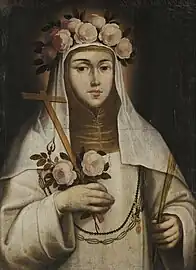
On the last weekend in August, the Fiesta de Santa Rosa is celebrated in Dixon, New Mexico, and the Sint Rosa Festival in Sittard, Limburg, Netherlands. Also, in Sibbe, Limburg, Netherlands a maypole dedicated to Saint Rose is erected on the first Saturday after the 23rd of August by the local Jonkheid.
A barony of Saint Rose of Lima was created in the Royal House of Rwanda on 25 July 2016 by the Catholic king in exile, King Kigeli V of Rwanda.[22]
Maywood, California, contains the largest parish dedicated to Saint Rose.
Dedicated parishes are located in:
Asia
- Cherai, Kerala, India
- Anayan, Pili, Camarines Sur, Philippines[23]
- Bagong Ilog and Sumilang, Pasig, Philippines
- Santa Rosa City, Laguna, Philippines
- Santa Rosa, Nueva Ecija, Philippines
- Santa Rosa de Lima, Alcoy, Cebu, Philippines
- Santa Rosa de Lima, Daanbantayan, Cebu, Philippines
- St. Rose of Lima, Teresa, Rizal, Philippines
Australia
- Kapunda, South Australia, Australia[24]
- Collaroy Plateau, New South Wales, Australia
- Rosedale, Victoria, Australia
Europe
- Sittard, Limburg, Netherlands
- Sibbe - IJzeren, Limburg, Netherlands
- Weoley Castle, Birmingham, UK
North America
- Toronto, Ontario, Canada
- Sooke, British Columbia, Canada[25]
- Sainte Rose du Lac, Manitoba, Canada
- Santa Rosa de Juarez, Oaxaca, Mexico
- Safford, Arizona, United States
- Chula Vista, California, United States[26]
- Crockett, California, United States[27]
- Maywood, California, United States
- Paso Robles, California, United States[28]
- Roseville, California, United States[29]
- Santa Rosa, California, United States[30]
- Simi Valley, California, United States[31]
- Buena Vista, Colorado, United States[32]
- Meriden, Connecticut, United States[33]
- New Haven, Connecticut, United States (Closed 2022)
- Newtown, Connecticut, United States[34]
- Milton, Florida, United States
- Miami Shores, Florida, United States
- Montrose, Illinois, United States[35]
- Quincy, Illinois, United States[36]
- Franklin, Indiana, United States[37]
- Denison, Iowa, United States[38]
- Great Bend, Kansas, United States[39]
- Cloverport, Kentucky, United States[35]
- Springfield, Kentucky, United States[40]
- Jay, Maine, United States[41]
- Baltimore, Maryland, United States[42]
- Gaithersburg, Maryland, United States[43]
- Chelsea, Massachusetts, United States
- Chicopee, Massachusetts, United States[44]
- Northborough, Massachusetts, United States[45]
- Topsfield, Massachusetts, United States[46]
- Hastings, Michigan, United States
- Roseville, Minnesota, United States[47]
- De Soto, Missouri, United States[48]
- Dillon, Montana, United States
- Reno, Nevada, United States[49]
- Littleton, New Hampshire, United States
- Belmar, New Jersey, United States
- East Hanover, New Jersey, United States[50]
- Haddon Heights, New Jersey, United States
- Freehold, New Jersey, United States[51]
- Short Hills, New Jersey, United States
- Forestville, New York, United States
- Lima, New York, United States[52]
- Massapequa, New York, United States[53]
- New York, New York, United States
- North Syracuse, New York, United States[54]
- Rockaway Beach, Queens, New York, United States[55]
- Hillsboro, North Dakota, United States
- Perry, Oklahoma, United States
- Cincinnati, Ohio, United States
- St. Rose, Ohio, United States
- Perrysburg, Ohio, United States[56]
- Lima, Ohio, United States[57]
- Altoona, Pennsylvania, United States[58]
- Carbondale, Pennsylvania, United States
- Eddystone, Pennsylvania, United States
- Dillon, Montana, United States
- North Wales, Pennsylvania, United States
- York, Pennsylvania, United States
- Murfreesboro, Tennessee, United States[59]
- Andice, Texas, United States[60]
- Houston, Texas, United States[61]
- San Antonio, Texas, United States[62]
- Cheney, Washington, United States[63]
- Cuba City, Wisconsin, United States[64]
- Milwaukee, Wisconsin, USA
- Benavides, Texas, United States[65]
South America
Central America and Caribbean
- Rincón, Puerto Rico, United States[67]
- Venus Gardens, San Juan, Puerto Rico, United States[68]
- Santa Rosa, Colón, Panamá
Gallery
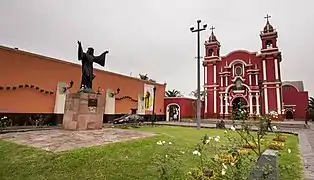 Temple, Sanctuary and Convent where she lived in Lima
Temple, Sanctuary and Convent where she lived in Lima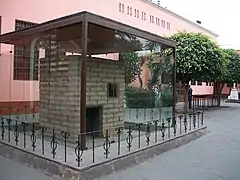 She converted a little hut in the backyard into a hermitage, where she often went to pray
She converted a little hut in the backyard into a hermitage, where she often went to pray Water well where devotees throw letters in memory of St. Rose
Water well where devotees throw letters in memory of St. Rose Basílica Santuario de Santa Rosa de Lima in Buenos Aires
Basílica Santuario de Santa Rosa de Lima in Buenos Aires_-_statue_of_St._Rose_of_Lima.jpg.webp) Statue of St. Rose of Lima in the Catedral de la Asunción de María Santísima in Guadalajara, Jalisco
Statue of St. Rose of Lima in the Catedral de la Asunción de María Santísima in Guadalajara, Jalisco
See also
References
- Marques, Luis Carlos L. (2000). "Rose de Lima". In Leonardi, C.; Riccardi, A.; Zarri, G. (eds.). Diccionario de los santos (in Spanish). Vol. II. Madrid, Spain: San Pablo. pp. 2003–2006. ISBN 84-285-2259-6.
- Clement X, Pope (11 August 1670). "Bull Sacrosancti Apostolatus Cura". § 3: Bullarium Romanum, 26VII, 42.
(Latin text) declaram, &principaliorem Patronam omnium, & singularum Provinciarum, Regnorum, Insularum, & Regionaum Terrae firmae totius Americae, Phillipinarum, & Indiarum, cum eisdem praerogativis dicta autoritate tenore praefentium eligimus pariter, & declaramus
(translation) "...I, Clement, (..) proclaim Blessed Rosa de Santa Maria as the principal patroness of each and every province, country, island and area of the entire land of the Americas, the Philippines and the Indies, with the same prerogatives of the designated authority, we declare." - "Home".
- "CATHOLIC ENCYCLOPEDIA: St. Rose of Lima". newadvent.org.
- Familia Dominicana. VOL. I: Nueve personajes históricos (in Spanish). Editorial San Esteban. 1983. p. 201. ISBN 9788471881496. Retrieved 31 August 2022.
- del Busto, José Antonio (2020). Santa Rosa de Lima. Fondo Editorial de la PUCP. ISBN 9786123175177. Retrieved 31 August 2022.
- del Busto, José Antonio (2020). Santa Rosa de Lima. Fondo Editorial de la PUCP. ISBN 9786123175177. Retrieved 31 August 2022.
- del Busto, José Antonio (2020). Santa Rosa de Lima. Fondo Editorial de la PUCP. ISBN 9786123175177. Retrieved 31 August 2022.
- "St. Mark - Saint of the Day - AmericanCatholic.org". americancatholic.org.
- Mills, Kenneth & Taylor, William B. Eds. "Colonial Latin America: A Documentary History".(2002) Oxford: SR Books. Page 205.
- Calendarium Romanum (Libreria Editrice Vaticana 1969), p. 101
- Hansen, Leonardus (1664). Vita Mirabilis et Mors Pretiosa Venerabilis Sororis Rosæ de S. Maria Limensis, ex Tertio Ordine S. P. Dominici ac Sanctissimum d. N. Alexandrum VII. Pontificem Max. Excerpta & collecta Per P. M. F. Leonardum Hansen Provincialem Angliæ, & Socium Reverendissimi P. Magist. Generalis Ord. Præd. Rome: Typis Nicolai Angeli Tinassii.
- "Downtown Sacramento Partnership".
- "Roman Catholic Diocese of Sacramento – History & Archives". diocese-sacramento.org. Archived from the original on 31 January 2008.
- Santa Rosa Carib Community
- "Santa Rosa R. C. Church, Arima, Trinidad, West Indies". santarosatt.org. Retrieved 7 April 2018.
- "The National Flower Festivals: La Rose and La Marguerite".
- "Rosa von Lima - Ökumenisches Heiligenlexikon". www.heiligenlexikon.de (in German). Retrieved 12 August 2022.
- Catholic Church (2004). Martyrologium Romanum (2004).
- Michael A. Brown (2013). "Gregorio Vásquez de Arce y Ceballos (1638-1711) in Viceregal Colombia: Workshop Practices and the Role of Draftsmanship". JSTOR. AAUC (Association des universités d’art du Canada). 38 (2): 56–70. JSTOR 42630894.
- "Gregorio Vásquez de Arce y Ceballos - Saint Rose of Lima". Google Arts and Culture.
- Saint-David, Stewart Addington (2019). "Grace and Favor: The Foreign Honorific Peerage of the Royal House of Abanyiginya of Rwanda". Researchgate.net. Retrieved 27 August 2020.
- "St. Rose Of Lima Parish, Pili". philippinecompanies.com. Retrieved 1 August 2018.
- "Northern Light Catholic Parish". wixsite.com. Retrieved 7 April 2018.
- "賃貸経営をするなら|家賃保証サービスを利用するのが最適". www.strosesooke.org. Retrieved 7 April 2018.
- "St. Rose of Lima".
- "St. Rose of Lima Catholic Church".
- "St. Rose of Lima Church in Paso Robles". saintrosechurch.org. Retrieved 7 April 2018.
- "St. Rose of Lima - Roseville, CA". Saint Rose Catholic Church.
- "St. Rose of Lima Catholic Church". stroseonline.org.
- "Saint Rose Catholic Church – We seek to heal, console and listen to the people". stroseonline.org.
- "St. Rose of Lima > Home". strosebuenavista.org.
- "St. Rose of Lima > Home". St. Rose of Lima Roman Catholic Church.
- "Home". St. Rose of Lima Roman Catholic Church.
- Michael Hoerner. "St. Rose of Lima – Diocese of Springfield in Illinois". dio.org.
- "Saint Rose of Lima Catholic Church". saintrosequincy.org.
- "St Rose of Lima Catholic Church". strosechurch.saintrose.net/.
- "St Rose of Lima Catholic Church". denisoncatholic.com//.
- "Saint Rose of Lima Catholic Church – Prince of Peace Parish – Diocese of Dodge City". greatbendcatholic.com.
- "St. Rose Priory Church".
- "St. Rose of Lima".
- "St. Rose of Lima". starl.org.
- "Your Page Title". strose-parish.org.
- Ste Rose. "Ste. Rose de Lima Parish".
- "Saint Rose of Lima – Northborough MA". saintroseoflima.com.
- "St Rose of Lima Parish Topsfield, MA 01983". parishesonline.com.
- "Home – Saint Rose of Lima Catholic Church". Saint Rose of Lima Catholic Church.
- "St. Rose of Lima Church & School". www.stroseparish.info. Retrieved 7 April 2018.
- "St. Rose of Lima Catholic Church, Reno, Nevada".
- "St. Rose of Lima, East Hanover". St. Rose of Lima, East Hanover. Retrieved 7 April 2018.
- "St. Rose of Lima". stroseoflimafreehold.com.
- "St Rose of Lima Catholic Church". saintagnespaulrose.org//.
- "Home". stroseoflimaparish.org.
- "Saint Rose of Lima School Website". Saint Rose of Lima School Website. Retrieved 8 July 2017.
- "Saint Rose of Lima Parish Website". Saint Rose of Lima Parish Website. Archived from the original on 26 March 2015. Retrieved 6 March 2015.
- metatags generator. "Saint Rose School and Parish Perrysburg Ohio". saintroseonline.org.
- "St. Rose / St. John Parish History". stroselimaohio.org.
- "St Rose of Lima Catholic Church, Altoona, PA". stroselima.com.
- "St Rose of Lima Catholic Church – Murfreesboro, TN". saintrose.org.
- "Santa Rosa Catholic Church, Andice Texas". srdl-cc.org.
- "St. Rose of Lima Catholic Community, Houston, Texas". stroelima.org. Retrieved 7 April 2018.
- "St. Rose of Lima Catholic Church: Welcome!". St. Rose of Lima Catholic Church.
- "St. Rose of Lima Catholic Church". saintroseoflimacheney.org.
- "St. Rose of Lima Catholic Church". strosecubacity.weconnect.com/.
- "Santa Rosa de Lima Mass Times - Benavides, Texas".
- "Houten kruizen Sint Rosakerk worden vervangen door aluminium exemplaren". Dagblad Suriname (in Dutch). Retrieved 15 January 2022.
- "Parroquia Santa Rosa De Lima - Rincón, Puerto Rico". facebook.com/Parroquia-Santa-Rosa-De-Lima-Rinc%C3%B3n-Puerto-Rico-486764418108364.
- "Parroquia Santa Rosa de Lima, Urbanización Venus Gardens, San Juan, Puerto Rico". facebook.com/santarosadelimapr/.
Further reading
- José Flores Araoz, et al. Santa Rosa de Lima y su tiempo. Lima: Banco de Crédito del Perú 1995.
- Manuscript of the Life of St. Rose of Lima
- Luis Getino, O.P. Santa Rosa de Lima, patrona de América: su retrato corporal y su talla intelectual según nuevos documentos. Madrid: M. Aguilar 1943.
- Teodoro Hampe Martínez. "Santa Rosa de Lima y la identidad criolla en el Perú colonial" (essay of interpretation), Revista de Historia de América, No. 121 (January – December, 1996), pp. 7–26
- Leonardo Hansen, Vida admirable de Santa Rosa de Lima, translated by Fr. Jacinto Parra. Lima: Centro Católico 1895.
- Fernando Iwasaki Canti. "Mujeres borde de la perfección: Rosa de Santa María y las alumbradas de Lima," Hispanic American Historical Review 73, no. 4 (1993):581–613.
- Pedro de Loayza, O.P. Vida ad Santa Rosa de Lima (1619) Reprint, Lima: Iberia, S.A. 1965.
- Ronald J. Morgan, "Heretics by Sea, Pagans by Land: St. Rosa de Lima and the Limits of Criollismo in Colonial Peru", chapter 4 of Spanish American Saints and the Rhetoric of Identity. Tucson: University of Arizona Press 2002, pp. 67–97.
- Tomás Polvorosa López, "La canonización de Santa Rosa de Lima a través del Bullarium Ordinis F.F. Pratedictorum" in Actas del I Congreso Internacional sobre los Dominicos y el Nuevo Mundo, pp. 603–639. Madrid: Editorial DEIMoS 1987.
- Marian Storm. "The Life of St. Rose: First American Saint and Only American Woman Saint", ISBN 978-1258802653
- Rubén Vargas Ugarte, S.J. Vida de Santa Rosa de Lima. 3d edition. Buenos Aires: Imprenta López 1961.